
Sampling a Roman Republican denarius for chemical analysis
New research from the University of Liverpool’s Department of Archaeology, Classics and Egyptology, together with the Department of Classics and Ancient History, University of Warwick, has used gold impurities in silver coins and lead pollution in Greenland ice to show that the Romans were early pioneers of recycling.
Extracting silver from ores and refining it at mints resulted in a lot of lead pollution. Ancient pollution entered the atmosphere, drifted across the Atlantic and left a pollution fingerprint in Greenland ice.
However, this research, published in the journal Archaeological and Anthropological Sciences, outlines that there was a dramatic decline in lead pollution levels in the ice during the late Roman Republic, even though coins were still being produced.
The research says that during the first and second centuries BC, Rome’s access to silver mines in Iberia and southern France was interrupted by conflict. Deliberate debasement of the denarii (the predominant silver coin of the Romans) with copper is often considered to show interruptions in silver production. Yet, despite slight dips in the fineness of silver coins (especially around the times of the Social and Civil Wars in the first century BC), this does not provide enough of an explanation for the drops in lead pollution.
To explain this phenomenon, Liverpool researchers Dr Jonathan Wood and Dr Matthew Ponting, point to the Romans recycling silver, often plundered following conflicts in Iberia and southern France, to make coins.
The researchers analysed how much of a different element was present in the coinage: gold, given that all silver produced in antiquity contains small quantities of gold.
At around 120 BC clusters of coins began appearing with very low levels of gold in them. The silver used for these coins also appears to have become part of the silver supply for coinage in the first half of the first century BC. Then, in 49 BC, a new infusion of silver with high levels of gold in it appears to enter circulation. Given that Julius Caesar returned to Rome from his battles with the Gauls in 49 BC, the researchers propose that this new silver in circulation was plundered by Caesar’s army.
The research paper forms part of the Rome and the Coinages of the Mediterranean 200 BCE – 64 CE European Research Council funded project, on understanding Roman monetary strategy as an instrument for imperialism.
Dr Jonathan Wood said: “Debasing silver was one way to deal with fluctuations in the silver supply. Melting down existing silver, either yours or someone else’s, was another.
“For the Romans, recycling coins would have been considerably less expensive than extracting new silver – a benefit for their finances, as well as for the environment.”
You can read the article about the research paper in The Economist here and read the paper in full here.